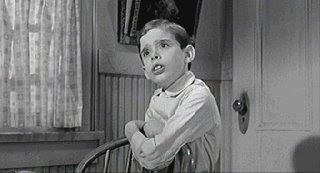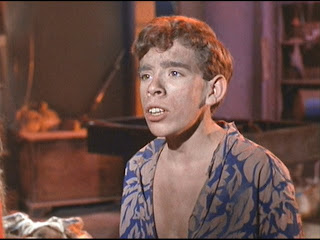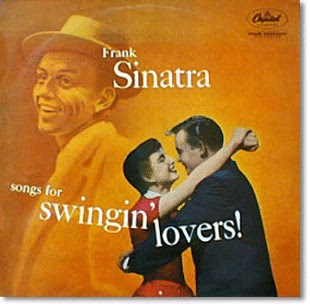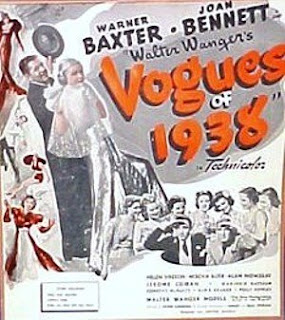February 28, 2009
ST: TNG made watchable and hilarious
February 26, 2009
Whatever happened to John Megna?

Megna portrayed Dill (Charles Baker Harris) in the 1962 film masterpiece, To Kill a Mockingbird. Dill is Jem and Scout Finch's summer neighbor and friend, and he represents the perspective of childhood innocence throughout Harper Lee's novel.
 He would reappear on my own personal cultural radar in season one of Star Trek, in the episode "Miri," originally broadcast on October 27, 1966 (two days after I was born). Though credited as "Little Boy," many no doubt think of him best as being the "bonk bonk on the head" kid.
He would reappear on my own personal cultural radar in season one of Star Trek, in the episode "Miri," originally broadcast on October 27, 1966 (two days after I was born). Though credited as "Little Boy," many no doubt think of him best as being the "bonk bonk on the head" kid.
Megna (might the name have been an issue?? should he have changed it?) performed some on the stage, and according to his IMDb entry, he appeared in several more minor TV and movie roles throughout the '70s and early '80s. Most significantly (in my humble onion), he portrayed the "Young Hyman Roth" in The Godfather Part II (1974).


After "cameo" roles (putting it nicely) in both Smokey and the Bandit II and Cannonball Run, I guess John figured the acting game was up, and he became a high school English teacher, last teaching at James Monroe High School in North Hills, CA. On September 5, 1995, in Los Angeles, California, he died from AIDS-related complications (damn, you hate to see that) at the age of 42 (source).

February 24, 2009
"Rise"
 During the summer of 1979 (could have been 1980), I spent a couple of weeks with my maternal grandparents. I was 12. And I'm not sure whether or not it's an insult to my grandparents, or Herb Alpert, but I tought myself to play the song "Rise" on a trumpet I found in their house. They had a bench hanging from an old pecan tree in the backyard, and there I spent hours torturing the nearby cattle (and anyone else within earshot) as I "perfected":
During the summer of 1979 (could have been 1980), I spent a couple of weeks with my maternal grandparents. I was 12. And I'm not sure whether or not it's an insult to my grandparents, or Herb Alpert, but I tought myself to play the song "Rise" on a trumpet I found in their house. They had a bench hanging from an old pecan tree in the backyard, and there I spent hours torturing the nearby cattle (and anyone else within earshot) as I "perfected":February 21, 2009
"Down to Earth"
 Wikipedia entry:
Wikipedia entry:"Down to Earth" is a single and part of the soundtrack album WALL-E, sung, written and produced by Peter Gabriel featuring The Soweto Gospel Choir; the music was composed by Peter Gabriel and Thomas Newman.
 The song has been nominated for the Golden Globe Award for Best Original Song at the 66th Golden Globe Awards and the Academy Award for Best Original Song at the 81st Academy Awards. It won the Grammy for Best Original Song from a Motion Picture.
The song has been nominated for the Golden Globe Award for Best Original Song at the 66th Golden Globe Awards and the Academy Award for Best Original Song at the 81st Academy Awards. It won the Grammy for Best Original Song from a Motion Picture.February 18, 2009
"Waterloo Sunset"
 Somehow on a hump day, the next best thing to it actually being Friday is to hear the lyrics "Terry meets Julie at Waterloo Station every Friday night..."
Somehow on a hump day, the next best thing to it actually being Friday is to hear the lyrics "Terry meets Julie at Waterloo Station every Friday night..."Selected bits from the Wikipedia entry:
"Waterloo Sunset" is a song released as a single by The Kinks in 1967, and featured on their album Something Else by the Kinks. It was composed and produced by The Kinks lead singer and songwriter Ray Davies and is one of the band's best known and most acclaimed songs.
 The record reached number 2 on the British charts in mid 1967 (it failed to dislodge the Beatles' "All You Need Is Love" from the number 1 position). Davies considered the song a professional milestone, where he managed to blend the commercial demands of a hit single with his own highly personal style of narrative songwriting. The elaborate production was the first Kinks recording produced solely by Davies, without longtime producer Shel Talmy. In subsequent arguments with Kinks management over the direction of the band, Davies would say "I've done 'Waterloo Sunset,' now I want to do something else."
The record reached number 2 on the British charts in mid 1967 (it failed to dislodge the Beatles' "All You Need Is Love" from the number 1 position). Davies considered the song a professional milestone, where he managed to blend the commercial demands of a hit single with his own highly personal style of narrative songwriting. The elaborate production was the first Kinks recording produced solely by Davies, without longtime producer Shel Talmy. In subsequent arguments with Kinks management over the direction of the band, Davies would say "I've done 'Waterloo Sunset,' now I want to do something else." A London FM radio poll in 2004 named this the "Greatest Song About London," while Time Out named it the "Anthem of London." It holds spot #42 on the list of Rolling Stone's 500 Greatest Songs of All Time. Influential pop music journalist Robert Christgau has called the song "the most beautiful song in the English language." Pete Townshend of The Who has called it "divine" and "a masterpiece." Allmusic senior editor Stephen Thomas Erlewine concurred, citing it as "possibly the most beautiful song of the rock and roll era."
A London FM radio poll in 2004 named this the "Greatest Song About London," while Time Out named it the "Anthem of London." It holds spot #42 on the list of Rolling Stone's 500 Greatest Songs of All Time. Influential pop music journalist Robert Christgau has called the song "the most beautiful song in the English language." Pete Townshend of The Who has called it "divine" and "a masterpiece." Allmusic senior editor Stephen Thomas Erlewine concurred, citing it as "possibly the most beautiful song of the rock and roll era." 
February 16, 2009
Twin Palms



Some background from a Los Angeles Times article and accompanying slide show:


 But not long after moving day, Sinatra had a change of heart. A sea change. He met Ava Gardner, the love of his life, and promptly left his wife Nancy, who begrudgingly granted him a divorce. Twin Palms soon became the setting for one of the 20th century's great romances, the amphitheater in which Sinatra and Gardner conducted their operatic affair. "Maybe it's the air, maybe it's the altitude, maybe it's just the place's goddamn karma," Gardner wrote in her 1990 autobiography, "but Frank's establishment in Palm Springs, the only house we really could ever call our own, has seen some pretty amazing occurrences."
But not long after moving day, Sinatra had a change of heart. A sea change. He met Ava Gardner, the love of his life, and promptly left his wife Nancy, who begrudgingly granted him a divorce. Twin Palms soon became the setting for one of the 20th century's great romances, the amphitheater in which Sinatra and Gardner conducted their operatic affair. "Maybe it's the air, maybe it's the altitude, maybe it's just the place's goddamn karma," Gardner wrote in her 1990 autobiography, "but Frank's establishment in Palm Springs, the only house we really could ever call our own, has seen some pretty amazing occurrences."


 Here's the portion of an AMC special called Legendary Hollywood Homes II in which Twin Palms is featured:
Here's the portion of an AMC special called Legendary Hollywood Homes II in which Twin Palms is featured:February 14, 2009
Gulf Coast Deco III
Visit my Houston Deco set at flickr? And now, on to the show:
First, the happiest place on Earth...not really, the Houston Casket Company (former), completed in 1935:
See it in its
And finally, as far as Art Deco is concerned, this is the last, but not least (in this post). The address I had entered into my Garmin for this place had it located a few blocks prior to the Almeda Court Apartments, but it wasn't there. So I thought it had been torn down. Imagine my profound joy then when I found it just a block away (and you'll excuse the number of shots I took):
Not necessarily Deco (the theater might be), but in Houston the day I was there:
I'd found one of these a week before in Dallas.
February 13, 2009
"You're Getting to Be a Habit with Me"
"You're Getting to Be a Habit with Me" was written by Harry Warren in 1932, with lyrics by Al Dubin. It appears in the 1933 musical 42nd Street, and is sung by Bebe Daniels:
The song was inspired by one of the women working at the Warner Brothers studio, who when asked why she was still dating a certain man, said that he was getting to be a habit with her (source). So I suppose Warren or Dubin were within earshot.
Here are Frankie Avalon and Vikki Carr doing a respectable job of it on a 1965 episode of the short-lived sitcom The Bing Crosby Show:
Frankie is clearly channeling another version, by another Frankie, my favorite recording of "You're Getting to Be a Habit with Me," the one on Sinatra's 1956 classic album, Songs for Swingin' Lovers!.
 This is one of those fantastic Sinatra/Nelson Riddle collaborations. I just love Riddle's cool, breezy arrangement, with its lush strings, vibes, those "Riddle flutes," and the playing of trumpeter Harry "Sweets" Edison. I've read somewhere Sinatra mandated that Edison should have his own microphone during the recording of Songs for Swingin' Lovers!, and it's easy to hear why on tracks such as this one. Longtime fans would have a hard time imagining many of Sinatra's recordings without Edison's playing.
This is one of those fantastic Sinatra/Nelson Riddle collaborations. I just love Riddle's cool, breezy arrangement, with its lush strings, vibes, those "Riddle flutes," and the playing of trumpeter Harry "Sweets" Edison. I've read somewhere Sinatra mandated that Edison should have his own microphone during the recording of Songs for Swingin' Lovers!, and it's easy to hear why on tracks such as this one. Longtime fans would have a hard time imagining many of Sinatra's recordings without Edison's playing.February 11, 2009
Sinatra and the Southern Breeze

Tired after a recent concert tour, Frank announced that he needed a month-long vacation and chartered the Southern Breeze, a 168-ft. yacht owned by Houston Businessman C. W. Edwards, for a reported $2,000 a day. Mostly he asked people his own age—respectable Hollywood matrons such as Claudette Colbert, Merle Oberon, Rosalind Russell, and their husbands. He also invited Mia Farrow, 20-year-old daughter of Actress Maureen O'Sullivan and the late Director John Farrow. (source)
 The ensuing voyage was probably the most closely watched since Cleopatra floated down the Nile to meet Mark Antony. Frank had been seeing Mia steadily for six months, and on the tip of every Hollywood tongue was the question: Was he or wasn't he? Married, that is. Mother O'Sullivan was positively snippy about it. "If Mr. Sinatra is going to marry anyone, he ought to marry me," she said. (source)
The ensuing voyage was probably the most closely watched since Cleopatra floated down the Nile to meet Mark Antony. Frank had been seeing Mia steadily for six months, and on the tip of every Hollywood tongue was the question: Was he or wasn't he? Married, that is. Mother O'Sullivan was positively snippy about it. "If Mr. Sinatra is going to marry anyone, he ought to marry me," she said. (source)
February 7, 2009
"That Old Feeling"

"That Old Feeling" was written by Sammy Fain, with lyrics by Lew Brown. The song was published in 1937. Frank Sinatra did a sublime version on his 1960 "not too happy, not too sad/not too fast, not too slow" album, Nice 'n' Easy. It has some great examples of the singer's incredible breath control (the "And when you caught my eye, My heart stood still" section - WOW! That's lung power) and clear pronunciation of the lyric. And of course, it's Sinatra, so he's singing to you, and only you:
 On a side note, the song first appeared in the 1937 movie Vogues of 1938.
On a side note, the song first appeared in the 1937 movie Vogues of 1938.
Subscribe to:
Comments (Atom)
